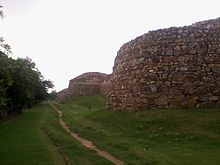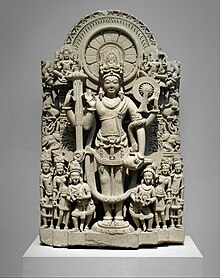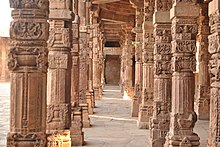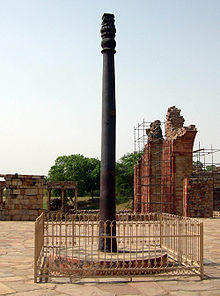Tomara dynasty
Tomara dynasty | |||||||||
|---|---|---|---|---|---|---|---|---|---|
| c. 736 CE–c. 1152 CE | |||||||||
Location of the Tomaras and neighbouring South Asian polities in 1000 CE.[1] | |||||||||
| Status |
| ||||||||
| Capital | |||||||||
| Common languages | |||||||||
| Religion | Hinduism | ||||||||
| Government | Monarchy | ||||||||
| History | |||||||||
• Established | c. 736 CE | ||||||||
• Disestablished | c. 1152 CE | ||||||||
| |||||||||
| Today part of | India | ||||||||

The Tomara dynasty (also called Tomar dynasty in modern vernaculars due to
They were displaced by the Chahamanas of Shakambhari in the 12th century, who took over their capital in Delhi, but who were themselves soon displaced by the Ghurid ruler Muhammad of Ghor in 1192 CE.[4]
Territory
The Tomara territory included parts of the present-day
History
The Tomaras are known from some inscriptions and coins. However, much of the information about the dynasty comes from medieval bardic legends, which are not historically reliable. Because of this, the reconstruction of Tomara history is difficult.[6]
As feudatories
The earliest extant historical reference to the Tomaras occurs in the
No information is available about the immediate successors of Gogga.[9] The Pehowa inscription suggests that this particular Tomara family was settled around the Karnal area. However, F. Kielhorn suggested that this Tomara family actually resided in Delhi: they may have visited Pehowa on pilgrimage, and built a temple there.[10]
As sovereigns
As the Pratihara power declined, the Tomaras established a sovereign principality around Delhi by the 10th century.[11] According to the bardic tradition, the king Anangapal Tuar (that is Anangapala II Tomara; not to be confused with the founder of the Tomara dynasty Anangpal I) founded Delhi in 1052 CE.[6] A 1526 CE source names the successors of Anangapala as Tejapala, Madanapala, Kritapala, Lakhanapala and Prithvipala. The Dravya-Pariksha (1318 CE) of Thakkura Pheru mentions the coins of Madanapala, Prithvipala and another ruler, Chahadapala.[12]

Soon after gaining independence, the Tomaras became involved in conflicts with their neighbours, the

The writings of the medieval Muslim historians suggest that a king named Mahipala was ruling Delhi in the 11th century. Although these medieval historians do not mention the dynasty of this king, he is identified as a Tomara ruler by some modern historians. Some coins featuring crude depictions of a horseman and a bull, and bearing the name "Mahipala", have been attributed to this king. These coins are similar to those of


Three Tomara kings seem to have shared the name "Anangapala" (
Decline
The bardic legends state that the last Tomar Rajput king, Anangpal Tomar (also known as Anangapala), handed over the throne of Delhi to his son-in-law Prithviraj Chauhan (Prithviraja III of the Chahamana dynasty of Shakambhari; r. c. 1179-1192 CE). However, this claim is not correct: the historical evidence shows that Prithviraj inherited Delhi from his father Someshvara.[6] According to the Bijolia inscription of Someshvara, his brother Vigraharaja IV had captured Dhillika (Delhi) and Ashika (Hansi). He probably defeated the Tomara ruler Anangapala III.[10]
See also
References
- ISBN 0226742210.
- ISBN 978-81-7824-088-6.
Discussion of the histories of various Rajput clans, such as the Chauhans, Kachhvahas, Chandelas, Pratiharas and Tomaras on the basis of a wide range of sources-literary, epigraphic, numismatic, bardic accounts and local traditions
- ISBN 978-0-415-32919-4.
When Gurjara Pratiharas power declined after the sacking of Kannauj by the Rashtrakutas in the early tenth century many Rajput princes declared their independence and founded their own kingdoms, some of which grew to importance in the subsequent two centuries. The better known among those dynasties were the Chaulukyas or Solankis of Gujarat and Kathiawar, the Chahamanas (i.e. Chauhans) of eastern Rajasthan (Ajmer and Jodhpur) and the Tomaras who had founded Delhi (Dhillika) in 736 but had been displaced by the Chauhans in the twelfth century.
- ISBN 978-0-429-80285-0.
- ^ a b P. C. Roy 1980, pp. 93–94.
- ^ a b c d D. C. Ganguly 1981, p. 704.
- ^ Sailendra Nath Sen 1999, p. 339.
- ^ Dilip Kumar Ganguly 1984, pp. 116–117.
- ^ D. C. Ganguly 1981, p. 705.
- ^ a b Dilip Kumar Ganguly 1984, p. 117.
- ^ a b Swati Datta 1989, p. 102.
- ^ Buddha Prakash 1965, p. 182.
- ^ Roma Niyogi 1959, p. 51-52.
- ^ R. B. Singh 1964, pp. 100–102.
- ^ H. A. Phadke 1990, p. 87.
- ^ Dasharatha Sharma 1959, p. 45.
- ISBN 978-0-429-80285-0.
- ISBN 0-486-42326-3.
- ^ P. C. Roy 1980, p. 95.
- ^ Upinder Singh 2008, p. 570.
Bibliography
- Buddha Prakash (1965). Aspects of Indian History and Civilization. Shiva Lal Agarwala. OCLC 6388337.
- D. C. Ganguly (1981). R. S. Sharma (ed.). A Comprehensive History of India (A. D. 300-985). Vol. 3, Part 1. Indian History Congress / Orient Longmans.
- Dilip Kumar Ganguly (1984). History and Historians in Ancient India. Abhinav. p. 117. ISBN 978-0-391-03250-7.
- H. A. Phadke (1990). Haryana, Ancient and Medieval. Harman. ISBN 978-81-85151-34-2.
- Jagbir Singh (2002). The Jat Rulers of Upper Doab: Three Centuries of Aligarh Jat Nobility. Aavishkar. ISBN 9788179100165.
- P. C. Roy (1980). The Coinage of Northern India. Abhinav. ISBN 9788170171225.
- R. B. Singh (1964). History of the Chāhamānas. N. Kishore. OCLC 11038728.
- Sailendra Nath Sen (1999). Ancient Indian History and Civilization. New Age. ISBN 9788122411980.
- Swati Datta (1989). Migrant Brāhmaṇas in Northern India. ISBN 978-81-208-0067-0.
- Dasharatha Sharma (1959). Early Chauhān Dynasties. S. Chand / Motilal Banarsidass. ISBN 9780842606189.
- Roma Niyogi (1959). The History of the Gāhaḍavāla Dynasty. Oriental. OCLC 5386449.
- ISBN 978-81-317-1677-9.
